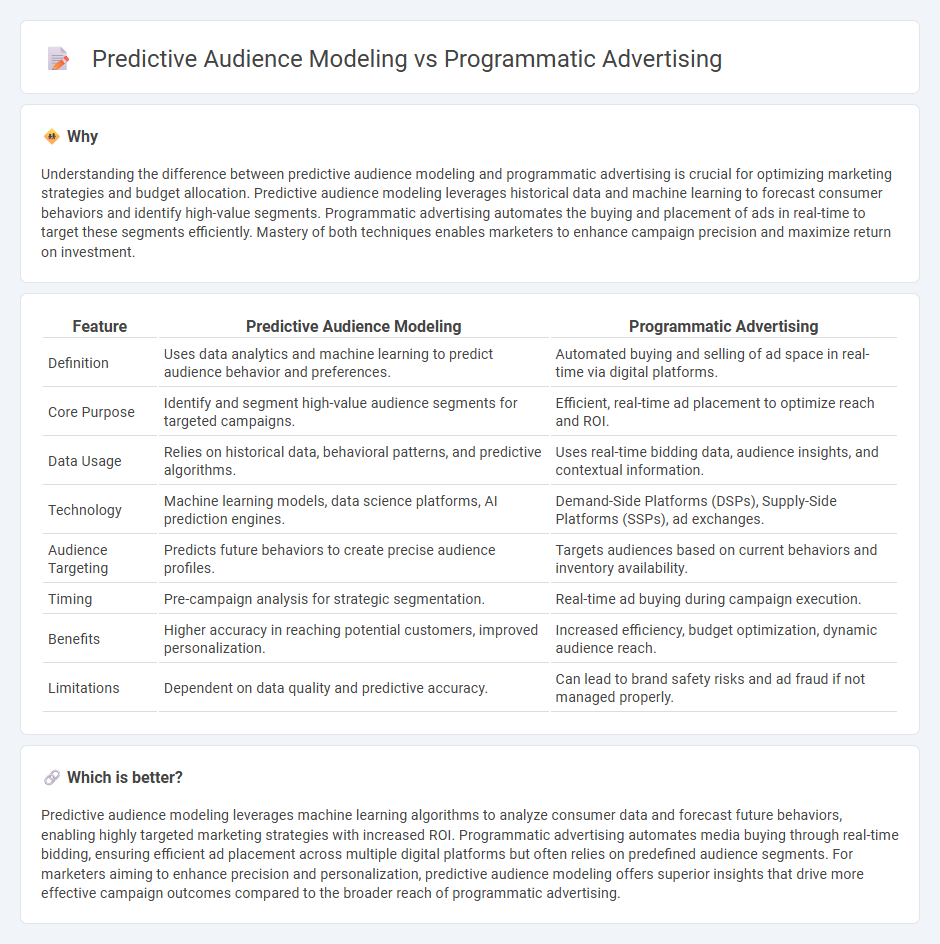
Predictive audience modeling leverages data analytics and machine learning algorithms to identify potential customers by forecasting their behavior and preferences, enabling highly targeted marketing campaigns. Programmatic advertising automates the buying and selling of digital ad space in real-time, using algorithms to optimize ad placements and maximize ROI. Discover how combining these strategies can transform your marketing efforts and enhance campaign performance.
Why it is important
Understanding the difference between predictive audience modeling and programmatic advertising is crucial for optimizing marketing strategies and budget allocation. Predictive audience modeling leverages historical data and machine learning to forecast consumer behaviors and identify high-value segments. Programmatic advertising automates the buying and placement of ads in real-time to target these segments efficiently. Mastery of both techniques enables marketers to enhance campaign precision and maximize return on investment.
Comparison Table
| Feature | Predictive Audience Modeling | Programmatic Advertising |
|---|---|---|
| Definition | Uses data analytics and machine learning to predict audience behavior and preferences. | Automated buying and selling of ad space in real-time via digital platforms. |
| Core Purpose | Identify and segment high-value audience segments for targeted campaigns. | Efficient, real-time ad placement to optimize reach and ROI. |
| Data Usage | Relies on historical data, behavioral patterns, and predictive algorithms. | Uses real-time bidding data, audience insights, and contextual information. |
| Technology | Machine learning models, data science platforms, AI prediction engines. | Demand-Side Platforms (DSPs), Supply-Side Platforms (SSPs), ad exchanges. |
| Audience Targeting | Predicts future behaviors to create precise audience profiles. | Targets audiences based on current behaviors and inventory availability. |
| Timing | Pre-campaign analysis for strategic segmentation. | Real-time ad buying during campaign execution. |
| Benefits | Higher accuracy in reaching potential customers, improved personalization. | Increased efficiency, budget optimization, dynamic audience reach. |
| Limitations | Dependent on data quality and predictive accuracy. | Can lead to brand safety risks and ad fraud if not managed properly. |
Which is better?
Predictive audience modeling leverages machine learning algorithms to analyze consumer data and forecast future behaviors, enabling highly targeted marketing strategies with increased ROI. Programmatic advertising automates media buying through real-time bidding, ensuring efficient ad placement across multiple digital platforms but often relies on predefined audience segments. For marketers aiming to enhance precision and personalization, predictive audience modeling offers superior insights that drive more effective campaign outcomes compared to the broader reach of programmatic advertising.
Connection
Predictive audience modeling leverages machine learning algorithms to analyze consumer data and forecast future behaviors, enhancing targeting precision in programmatic advertising. Programmatic advertising automates ad buying in real time, using insights from predictive models to deliver personalized ads to the most relevant audiences. This integration maximizes campaign efficiency by optimizing ad spend and improving conversion rates through data-driven audience segmentation.
Key Terms
**Programmatic Advertising:**
Programmatic advertising leverages automated technology and real-time bidding to deliver targeted ads efficiently across multiple digital platforms, maximizing reach and ROI. It uses data-driven algorithms to optimize ad placements based on user behavior, demographics, and context, ensuring relevant messaging to the right audience at the right time. Discover how programmatic advertising can transform your marketing strategy with advanced targeting and scalability.
Real-Time Bidding (RTB)
Programmatic advertising automates media buying through Real-Time Bidding (RTB), allowing advertisers to bid on individual ad impressions in milliseconds, maximizing efficiency and targeting precision. Predictive audience modeling enhances RTB by utilizing machine learning algorithms to analyze historical data and predict user behavior, enabling more accurate bid decisions and audience segmentation. Explore how integrating predictive models with RTB can elevate campaign performance and return on ad spend.
Demand-Side Platform (DSP)
Programmatic advertising leverages automated bidding on DSPs to purchase digital ad space in real-time, optimizing campaign reach and efficiency across multiple channels. Predictive audience modeling utilizes machine learning algorithms within DSP platforms to analyze behavioral data and forecast user engagement, enabling precise targeting and improved ROI. Explore how integrating these technologies can transform your digital marketing strategy.
Source and External Links
Programmatic Advertising - What It Is and How It Works - Amazon Ads - Programmatic advertising automates media buying to deliver digital ads using marketing technology, optimizing campaigns across various platforms.
What Is Programmatic Advertising? How Does It Work? - Programmatic advertising uses automated technology and algorithms to efficiently buy and sell digital ad space, targeting the right audience at the right time.
What Is Programmatic Advertising? How Does It Work? - Publift - Programmatic advertising automates the sale of digital ad space using AI and machine learning, ensuring targeted ads reach suitable audiences in real-time.
 dowidth.com
dowidth.com